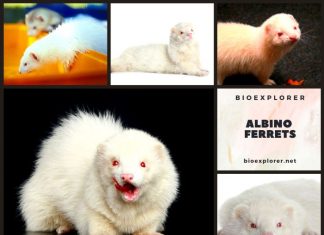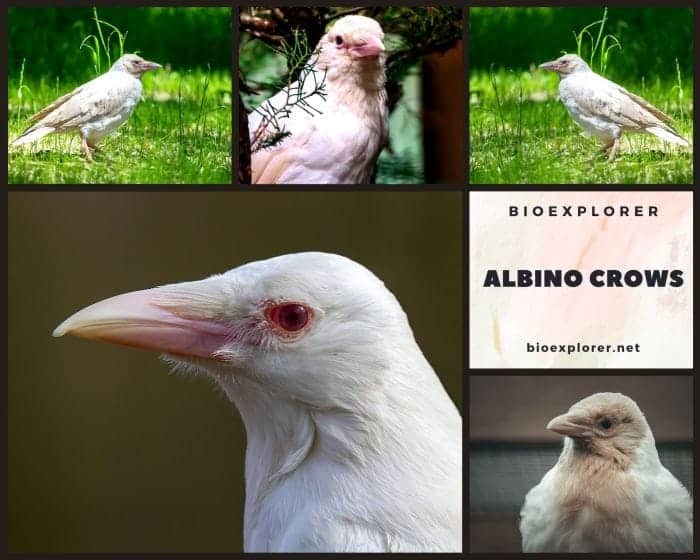
Albino crows are an exceptionally rare sight in the bird world. With their snowy white plumage, pink eyes, and pale beaks, they stand out dramatically from their normal black-feathered crow counterparts.
While no accurate estimates exist on their prevalence, albino crows are thought to occur only once in every 30,000 or 100,000 births. This rare genetic condition results from a lack of melanin pigment due to a genetic mutation.
Key Takeaways
- The genetic and hereditary causes behind albinism in crows.
- Where albino crows can potentially be observed in captivity and nature.
- The scientific and ecological significance of albino crows.
- Their unusual appearance makes survival difficult in the wild.
- How to properly care for an albino crow in captivity.
- Other bird species besides crows that can exhibit albinism.
- The value of albino crows for advancing genetics research.
- They have cultural significance as symbolic messengers and omens.
- A summary of why these strikingly pigmentless birds are so noteworthy.
![]()
For an albino crow, life in the wild poses many extra challenges. Their bright white coloration makes them easy targets for predators. Additionally, their vision and hearing are often impaired due to the lack of pigment in their eyes and ears. These difficulties mean albino crows rarely survive long without human intervention.
But the existence of these unique albino crows provides fascinating insights into crow genetics, adaptation, and key factors that allow crows to thrive. Their distinctive appearance illustrates how important pigmentation is for typical crow survival strategies.
While a sighting of an albino crow is exceedingly unusual, it holds special meaning for many cultures. In some Native American tribes, a white crow sighting signifies a great blessing. Albino crows have also taken on symbolic importance in mythology, stories, and dreams as messengers or signs of monumental change. For wildlife rehabilitators and bird enthusiasts, caring for one of these rare crows can be an unforgettable experience.
Table of Contents
- Key Takeaways
- What Crow Species Tend to Have Albinism?
- Unique Physical Characteristics of Albino Crows
- How Does Albinism Affect Feather and Tissue Pigmentation?
- What Other Characteristics are Affected by Albinism in Crows?
- Challenges Facing Albino Crows in the Wild
- Albino Crows in Captivity
- Causes of Albinism in Crows
- Symbolism and Cultural Significance of Albino Crows
- Where to See Albino Crows?
- The Significance of Albino Crows
- Other Albino Birds
- Caring for an Albino Crow
- Frequently Asked Questions
- Conclusion
What Crow Species Tend to Have Albinism?
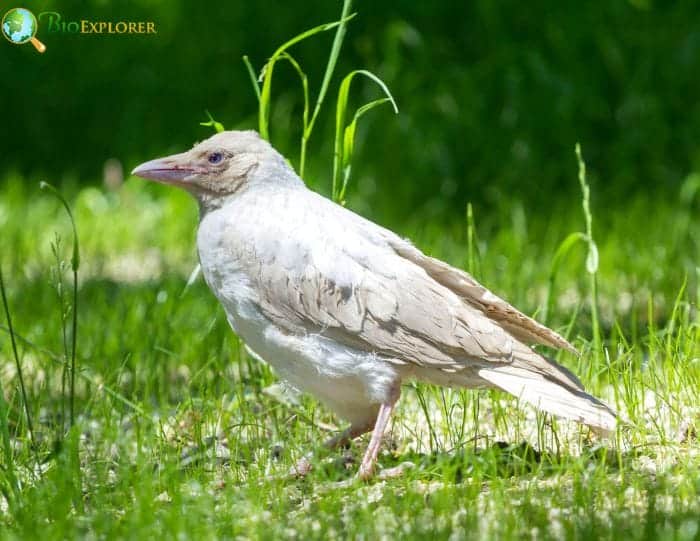
Albinism has been observed in several of the most common crow species, though some types appear to be more prone to this genetic mutation than others.
- The American crow, widespread across North America, and the closely related Northwestern Crow of the Pacific Northwest exhibit higher rates of albinism than other crow species.
- Albino fish crows, smaller cousins of the American Crow that inhabit the southeastern United States, have also been periodically documented. In one sighting, an entirely white fish crow with pink legs and eyes was spotted in Florida.
- Among corvids (the crow and raven family), common ravens seem particularly susceptible to albinism compared to other corvid species. Ravens with all-white plumage and pink eyes have been spotted from California to Maine.
- A few reports of albino carrion crows are predominantly found across Europe and Asia. One albino Carrion Crow was rescued in Germany in 2018.
- Albino jungle crows and house crows, both native to Asia, are rarer but have been spotted on occasion. In India, an albino house crow frequented a busy marketplace, easily spotted amongst its black-feathered kin.
- Magpies, close corvid cousins of crows, also occasionally produce albino offspring. Albino Eurasian magpies have been documented in Spain, Sweden, and elsewhere.
- While less common, albino jackdaws, Rooks, and other corvid species have been sighted over the years as well.
- For most other crow species, including the Hawaiian crow, Mariana crow, and little crow, albino individuals are exceptionally rare or yet to be reported in scientific literature.
The prevalence of albinism depends on how common the recessive gene is in a given crow population, in addition to random genetic mutations. Due to limited data, it’s challenging to pinpoint exactly which crow species are most likely to produce albino offspring. However, the unique white crows that occasionally appear demonstrate albinism can arise even in species where it seldom occurs.
Suggested Reading:
Albino Monkeys
Why Do American and Northwestern Crows Have Higher Rates of Albinism?
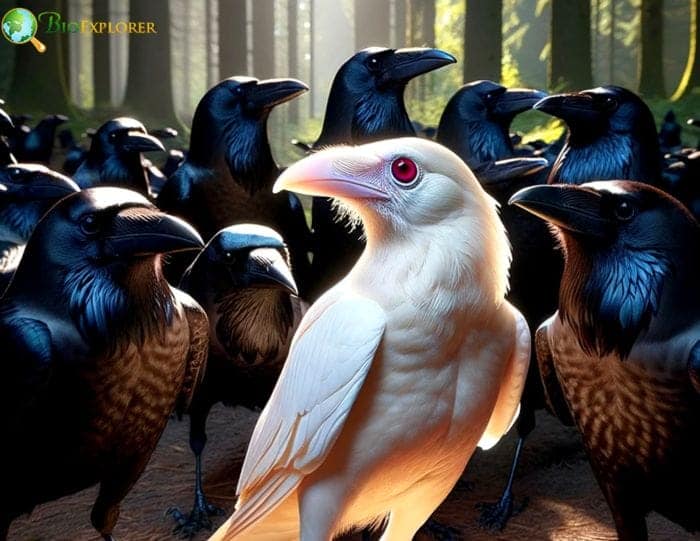
There are a couple of theories as to why American crows and northwestern crows seem to have higher rates of albinism compared to other crow species[1]:
- Population Size: American and northwestern crows have very large overall populations across North America. With more total individuals, the chance of rare albino genetic mutations increases[2].
- Frequency of Recessive Gene: The recessive gene variant that causes albinism may be more common in American/northwestern crow populations than other species. When both parents carry the recessive allele, there is a 25% chance of an albino chick.
- Founder Effect: Higher rates of albinism may be traced back to a few ancestral crows that carried the recessive allele. As American and northwestern crow populations expanded, they spread this gene variation.
- Hybridization: There is some hybridization between American crows, northwestern crows, and Fish Crows where their ranges overlap. Hybrid offspring could inherit albinism genes.
- Less Predation Pressure: American and northwestern crows thrive in human-altered environments with fewer predators, so albino offspring have a better chance of surviving.
![]()
Genetic Factors Contributing to Albinism in Crows
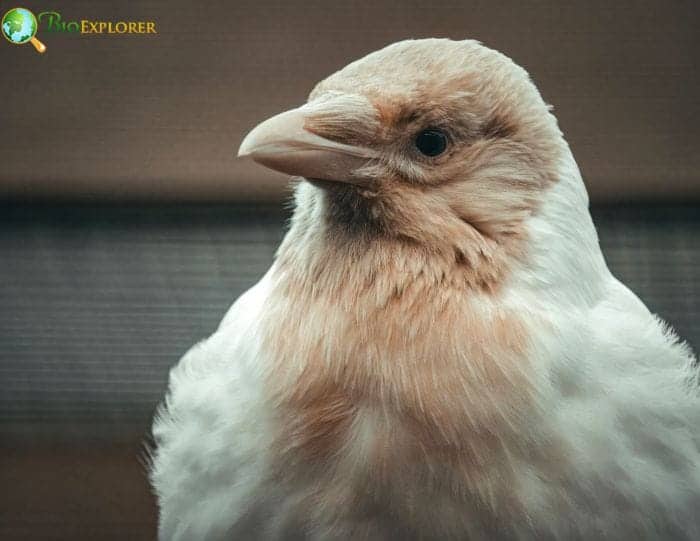
- It is caused by a recessive mutation in the tyrosinase gene TYR that regulates melanin production[3] gene).
- Both parents must carry one copy of the mutated albino gene to have albino offspring.
- If one parent is albino and one normal, all offspring will be carriers.
- Albino crows inherit one albino TYR gene and one normal gene from their parents.
- The normal TYR gene can produce some melanin, allowing for partial albinism.
- Other mutations on regulatory genes like SLC45A2 can also cause albinism by disrupting melanin[4].
- Albino offspring are rare due to both parents carrying recessive genes.
Suggested Reading:
Albino Ferrets
How Common are Fully Albino Crows Compared to Partial Albinism?
- True albino crows, with completely white feathers, pink eyes, and pale bills, are estimated at 1 in 30,000 to 100,000 births.
- Partial albino crows, with some white patches or spotting mixed with normal black feathers, are much more common.
- Partial leucism[5], causing irregular white spotting, is estimated to occur in 1 in 10,000 crows.
- The partial leucistic phenotype results when birds inherit one normal pigment gene and one mutated copy.
- Approximately 10-15% of crows display some degree of partial leucism.
- Partial albinos have higher survival rates than true albinos as they retain some pigment to blend into flocks.
- Truly, albino crows rarely survive long in the wild due to vision impairment and lack of camouflage.
![]()
Unique Physical Characteristics of Albino Crows
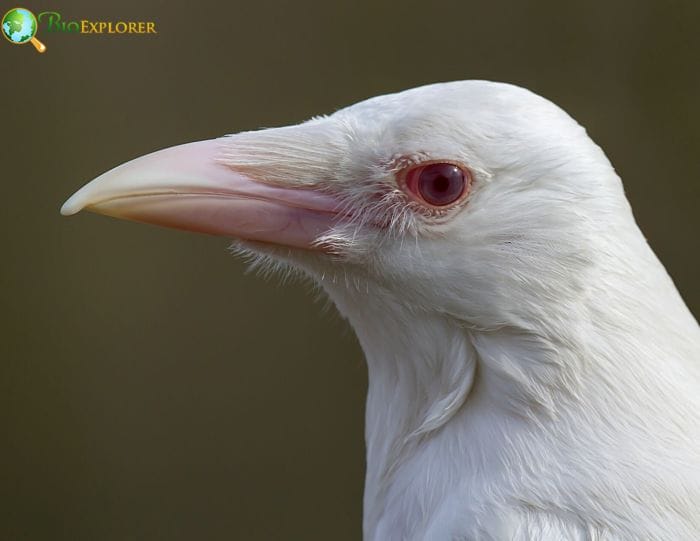
The most dramatic difference in appearance between albino crows and normal black crows is their pure white plumage. While black crows have a mix of iridescent purples, blues, and greens in their dark feathers, albino crows’ feathers are snow-white.
Plumage
- The feathers of an albino crow appear chalk white or ivory without any black pigment.
- When sunlight hits their feathers, they do not produce the pretty iridescent sheens that black crow feathers do.
- Albino crows completely lack the black melanin that would absorb UV radiation, making their feathers highly reflective white.
![]()
Eyes
- Rather than having dark brown or black Irises, albino crows have light pink eyes. Their Irises may also have a vivid red or even pale purple-blue tint.
- The blood vessels at the back of their eyes show through the unpigmented irises more strongly, causing a red appearance.
- White eyelashes and eyebrows around the pink eyes add to their distinctive facial appearance.
![]()
Bill and Legs
- An albino crow’s bill lacks melanin, so it appears to be a pale horn color rather than black. The precise shade can range from pink to yellow.
- Their legs and feet appear flesh-toned pink, yellow, or orange rather than blackish-gray.
- The scales on their legs often have a noticeable reddish tint due to blood vessels showing through.
![]()
Overall Size
- Albino crows are typically the same overall size as non-albino crows of the same species.
- Their body size, wingspan, and weight do not differ from normal crows.
- Albinism only impacts pigmentation, not growth and development.
![]()
Voice
- The calls and vocalizations of albino crows sound the same as non-albino crows.
- They make the characteristic “caw” sounds, rattles, and clicks of their species.
- Albinism does not affect their voice box or sound production.
![]()
Soft Tissues
- The skin, muscles, and internal organs of albino crows lack dark pigment.
- Instead of black, their tissues will appear pink, red, or creamy white.
- Albinism affects melanin production throughout the body, not just the feathers.
![]()
How Does Albinism Affect Feather and Tissue Pigmentation?
- Albinism prevents melanocyte cells from producing the black-brown melanin pigments eumelanin and pheomelanin.
- This causes a complete lack of melanin production in feathers, causing them to appear white.
- Tissues like skin and blood vessels also appear unpigmented and take on a pink or red hue.
- The specific gene mutations responsible include the TYR gene, which regulates tyrosinase enzyme activity needed for melanin synthesis.
- Mutations in genes like SLC45A2 can also disrupt melanin production by altering the pH and transport of pigment components.
- While partial leucistic crows retain some melanin, true albino crows cannot synthesize melanin throughout the body.
![]()
What Other Characteristics are Affected by Albinism in Crows?
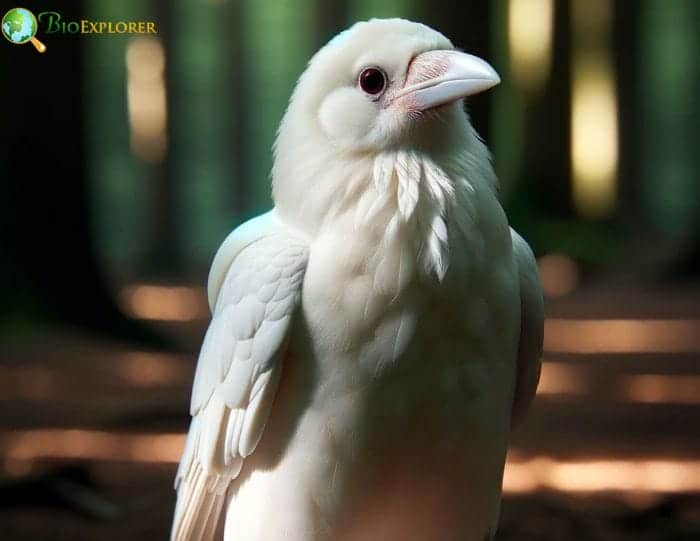
- Vision: Albino crows often have impaired vision due to a lack of eye pigment. They can be sensitive to light and have reduced visual acuity. Albinism also causes involuntary nystagmus eye movements and unsteady gaze.
- Hearing: The lack of melanin in the inner ear may cause hearing difficulties for albino crows. However, the specific effects on hearing ability require further research.
- Immune function: Melanin offers some protection against UV radiation and also has antioxidant properties. Albino crows lack these benefits, potentially reducing immunity. However, the magnitude of this effect is still scientifically unclear.
- Behavior: Albino crows do not display inherent behavioral differences due to albinism alone. But vision and survival challenges in nature may lead to atypical habits compared to normal crows. In captivity, their behavior appears similar.
- Reproduction: When paired with normally pigmented crows, albino crows can successfully breed and reproduce. Albino-albino pairing can also produce viable eggs. Low survival in the wild prevents mating opportunities.
- Life span: Albino crows have a high mortality rate in natural environments, with most perishing early. But in human care, they can potentially live full, normal lifespans over 10-20 years like non-albino crows.
![]()
Challenges Facing Albino Crows in the Wild
- Increased predation: The stark white feathers of an albino crow make it incredibly easy to spot against the black plumage of a normal flock. Predators like hawks, owls, and eagles can readily pick an albino crow out as prey compared to its camouflaged peers. Albino crows may also have difficulty seeing predators approaching due to impaired vision.
- Rejection by peers: Fellow crows recognize albino birds as abnormal and often Single them out for aggression or exclusion from the social group. Being rejected and attacked by other crows leaves albino crows vulnerable without the flock’s safety. They can become isolated targets for predators.
- Vision difficulties: The lack of pigment in albino crows’ eyes leads to photosensitivity, poor visual acuity, and involuntary eye movements. This makes key survival tasks like foraging for food scraps, flying through complex environments, and pursuing mates much more challenging. Albino crows’ sensory handicap puts them at a major disadvantage.
- Sunburn susceptibility: Unlike black-feathered crows, albino crows lack protective melanin pigment in their skin and feathers. This puts them at extreme risk of sunburn, overheating, and skin cancer from UV radiation exposure. Sun damage further compromises their health.
- Competition for resources: Between their poor eyesight and social exclusion, albino crows can struggle to compete with normal crows over vital resources like food sources, water, nesting sites, and mates. Their reduced abilities make it difficult to assert themselves, which can indirectly threaten their survival.
![]()
Albino Crows in Captivity
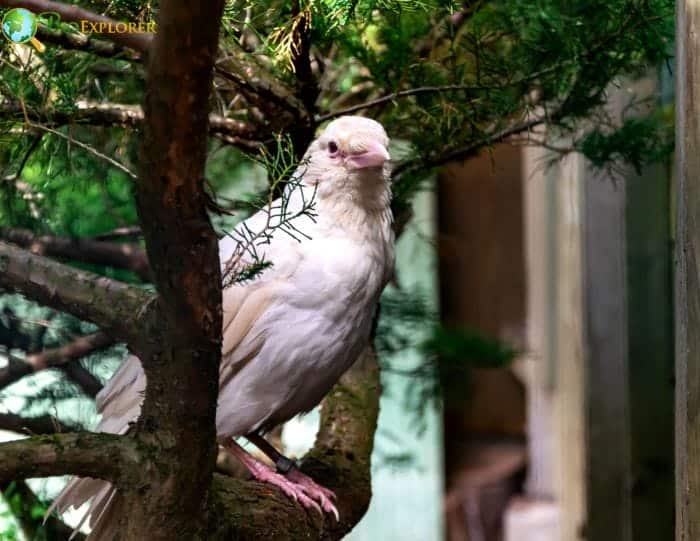
While albino crows face steep odds of surviving in the wild, they can thrive under human care in captivity.
- Protection from predators: In the controlled setting of a zoo or wildlife facility, albino crows are safely enclosed and housed to prevent predation. Outdoor aviaries use protective netting and barriers so birds of prey cannot reach them. This removes the constant threat of being hunted.
- Veterinary care: Qualified avian veterinarians provide specialized medical care for captive albino crows. Wellness exams, prompt diagnosis and treatment of injuries or illnesses, and optimized nutrition help support their health and address any issues related to albinism. Keepers closely monitor their condition.
- Controlled environment: Albino crows are kept indoors or given shaded, covered shelter outdoors to avoid overexposure to sunlight and heat. Their enclosures have lighting designed to meet their needs. Keepers work to create comfortable ambient temperatures suited to albino crows.
- Social interaction: Hand-rearing baby albino crows allow them to imprint on their caregivers and provide crucial social bonding. Housing albino crows together allows social flock dynamics to develop. Interacting with keepers enriches their mental health.
- Enriched lives: Providing albino crows with enrichment activities helps prevent boredom and promotes natural behaviors. This can include perches, baths, toys, foraging activities, and training exercises. Medical care and life enrichment enable albino crows to live fulfilling lives.
![]()
How Do Albino Crows Come into Captivity?
There are a few primary ways in which albino crows are brought into captive populations in zoos, wildlife sanctuaries, and research facilities:
- Rescue: If a baby albino crow falls from its nest or is orphaned/injured in the wild, wildlife rehabilitators may take it into care rather than release it due to low survival odds. These rescues provide founders for captive populations.
- Selective breeding: Facilities with albino crows may intentionally breed them to produce more albino offspring for research and educational display. This expands the captive population.
- Wild-caught: On very rare occasions, mature albino crows are captured directly from the wild using nets/traps so they can be given protected sanctuary. This is highly controversial today.
- Transfers: Zoos and sanctuaries may trade or loan albino crows between institutions for breeding on cooperative programs. This helps diversify genetics.
- Confiscations: Authorities may seize illegally held albino crows and place them in licensed facilities if welfare concerns exist. This shifts them into proper care.
Responsible facilities today focus on captive breeding, rescue, and cooperation to obtain albino crows rather than wild capture. Careful management helps preserve this rare genetic variant.
Suggested Reading:
Top 15 Wildlife Biology Degree Programs In The USA
What Medical Issues Do Captive Albino Crows Commonly Face?
Albino crows under human care require specialized medical management to support their health needs. Some common medical issues seen in captive albino crows include:
- Vision problems: Ophthalmic exams help diagnose and manage impairments like photosensitivity, poor acuity, and nystagmus. Lens damage is also monitored.
- Skin cancer: Without protective melanin, albino crows are prone to UV-induced skin cancers. Keepers monitor for lesions/tumors and treat them accordingly.
- Sunburn: Their skin can easily redden and burn when unprotected from sunlight. Keepers treat sunburn and make sure shade is available.
- Injuries: Their poor vision makes albino crows prone to minor trauma and self-mutilation. Wounds must be treated promptly.
- Nutrient deficiency: Special diets with added vitamin A, calcium, and other nutrients may help compensate for any deficiencies related to albinism.
- Infection: Albino crows may be more prone to bacterial/fungal infections without full immune protection. Antibiotics or antifungals are used when needed.
Suggested Reading:
Top 14 Most Infectious and Deadliest Diseases Caused By Bacteria
Regular exams, prompt treatment, and preventative care enable albino crows to be successfully managed despite their genetic challenges. A specialized approach helps them thrive.
![]()
Causes of Albinism in Crows
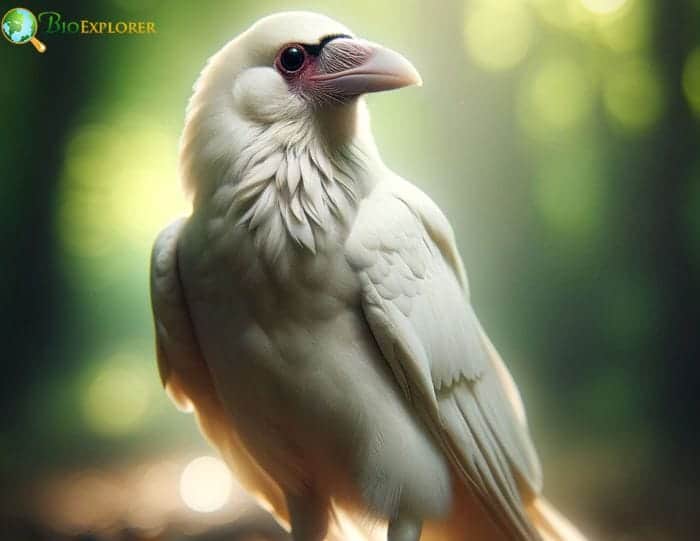
The striking white plumage of albino crows is caused by a genetic mutation that disrupts the birds’ ability to produce melanin pigment. Albinism results when a crow inherits a copy of this defective recessive gene from both parents[6].
- For a crow to exhibit albinism, both parents must be carriers of the recessive albino gene. If one parent passes on the mutant albino gene, and the other passes on a normal dominant pigment gene, the offspring will remain a carrier but not fully albino.
- Only when two carrier crows’ mate and each pass on the defective recessive gene does the offspring inherit albinism, expressing white feathers. This double recessive inheritance is why albinism is rare in the wild.
- In captivity, selectively breeding carrier crows produces a higher frequency of albino birds inheriting the double recessive genotype. The specific mutated gene disrupts an enzyme vital to melanin production during development.
- When both copies of this gene are defective, the albino crow loses all ability to synthesize melanin pigment, resulting in completely white plumage uncamouflaged in nature.
This illustrates the key role genetics plays in albinism.
![]()
Symbolism and Cultural Significance of Albino Crows
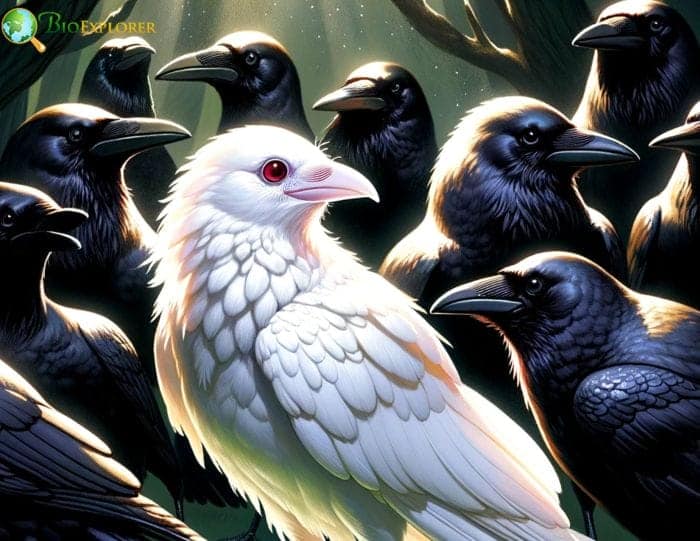
With their rare white plumage, albino crows have long captured the human imagination and taken on rich symbolic meaning across cultures and legends. In many societies, the conspicuous albino crow has been seen as an outlier associated with reverence and superstition.
- Connection to the sun: Ancient Egyptian and Celtic cultures linked the albino crow to solar deities, spinning stories of the white crow bringing the sun. This reflects the stark contrast between the white crow and the black night.
- Spiritual beliefs: In some Native American tribes, spotting an albino crow was thought to signify coming change or a message from the spirit world, imbuing these unusual birds with mysticism.
- Death omens: In many European mythologies, the appearance of an albino crow foretold doom, plague, or death. Their ghostly white form took on an ominous tone.
- Tricksters: In folk tales from various regions, the albino crow is portrayed as a mischievous trickster defying expectations and upending the natural order. Their unpredictability made them untrustworthy omens.
![]()
Where to See Albino Crows?
Due to their lack of natural camouflage, albino crows rarely survive long in the wild. Spotting one is extremely uncommon outside of captivity. However, there are a few places where albino crows may occasionally be observed:
- Wildlife rehabilitation centers sometimes take in injured or abandoned albino crow fledglings, hand-raising them in captivity if they cannot be released.
- Zoos and aviaries with captive albino crow populations may display white crows as educational specimens for breeding programs.
- Birding hotspots provide the best opportunity to potentially spot an albino crow in nature, though sightings are very rare.
- Viral photos and videos may document a wild albino crow. Their unique appearance draws attention and interest when spotted.
- University research laboratories may study albino crows for scientific purposes to understand their genetics.
Sighting an albino crow often comes down to chance, as their camouflage disadvantage makes prolonged survival in the wild challenging. But captivity allows the public to observe these rare pigment-less birds.
![]()
The Significance of Albino Crows
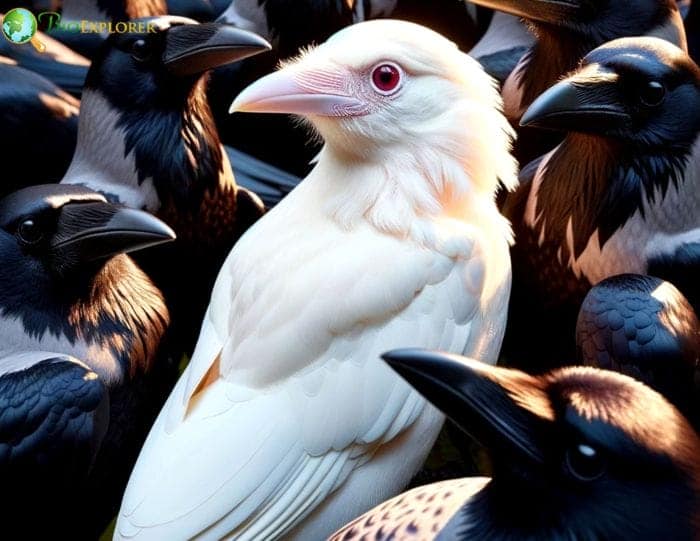
While quite rare, the occurrence of albino crows holds several points of scientific and ecological significance:
- Albino crows provide insights into genetic mutations and variation within corvid populations. Studying albinism increases understanding of recessive traits, inheritance patterns, and gene pool diversity in crows.
- Their total lack of melanin pigmentation demonstrates how essential camouflage coloration is to crows’ survival in the wild. Albino crows illustrate the strong selective disadvantage of lacking normal pigment.
- Observing the significant challenges albino crows face in nature highlights the broader difficulties albino animals encounter across species when lacking natural coloration.
- Tracking sightings and rates of albinism contributes to monitoring overall genetic diversity and tracing the persistence of recessive traits in wild crow lineages over time.
- As striking and rare genetic aberrations, albino crows capture public interest and attention. Their uniqueness provides opportunities to inspire greater environmental awareness.
- The specific albinism mutation reveals key information about the genetic pathways and enzymes involved in melanin production during the development of birds and other organisms.
Though their conspicuous white plumage makes life exceedingly difficult, albino crows significantly advance diverse areas of scientific knowledge. Their rarity makes them valuable subjects to study variation.
![]()
Other Albino Birds
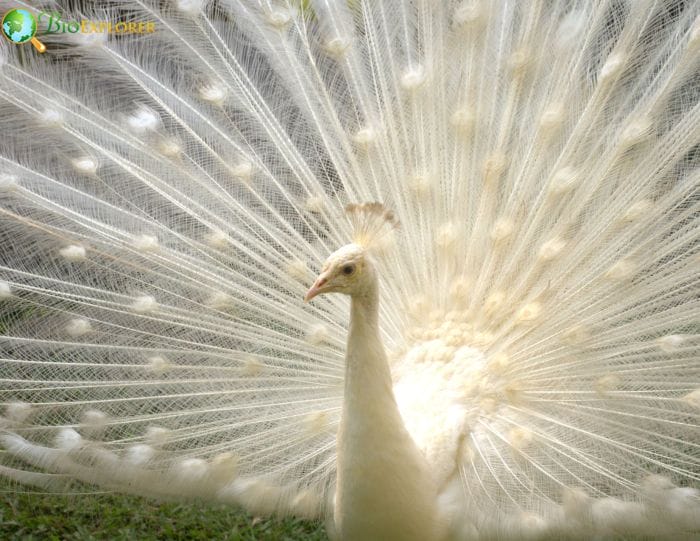
While albino crows are quite rare, albinism has been observed in various other bird species as well:
- Albino peacocks, with their snowy white plumage, are among the most visually striking albino birds. However, their lack of camouflage makes them easy prey.
- Albino hummingbirds, with pure white feathers contrasting against their typical vibrant colors, have been spotted occasionally. They often do not survive long.
- Endangered albino black swans arise occasionally, their all-white cygnet plumage standing out from the normal grey juveniles.
- On rare occasions, albino robins with brilliant red breasts but snowy white heads and bodies have been sighted in nature.
- White albino sparrows and finches pop up in populations, showing how pigment mutations can occur across species.
- Raptors like hawks, eagles, and owls with albino color variations have been documented, though they rarely thrive in the wild.
- Even flashy tropical species like parrots and macaws exhibit albinism, with all-white mutants appearing in captive flocks.
![]()
Caring for an Albino Crow
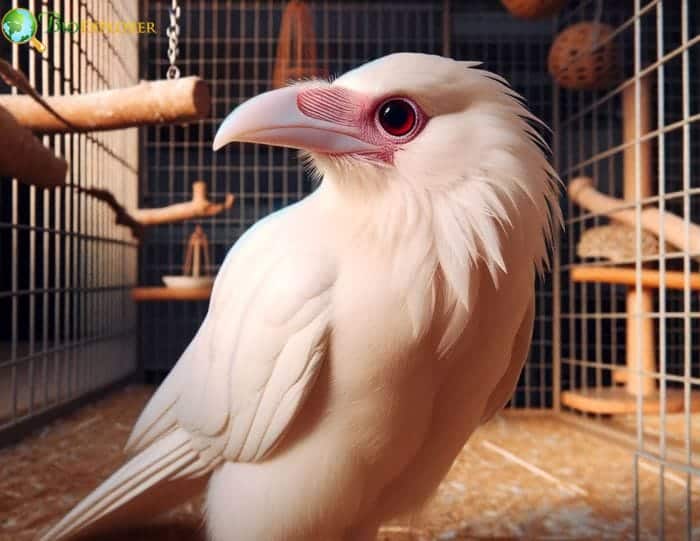
Due to their lack of camouflage, albino crows do not fare well in the wild. But with special care, they can survive well in captivity:
- Orphaned albino crow chicks may be hand-raised by wildlife rehabilitators until they can eat independently. Providing shade and covering is essential.
- In enclosures, providing visual cues using contrasting colors and patterns can help albino crows orient themselves since their vision is impaired.
- Albino crows should be given ample shelter from direct sunlight, which their skin and eyes are highly sensitive to. Access to shade is crucial.
- Dietary supplements high in vitamin D can help albino crows metabolize calcium since they cannot synthesize vitamin D from sunlight.
- Ongoing veterinary care is important, as albino crows are prone to health issues like deformities, seizures, and heart conditions.
With attentive daily care and adaptations like filtered light and high-contrast surroundings, albino crows can survive and even thrive in avian facilities and sanctuaries.
![]()
Frequently Asked Questions
Is it rare to see a white crow?
Seeing a completely white crow, known as an albino crow, is exceptionally rare both in the wild and in captivity. This is because the albino color mutation requires a recessive gene to be inherited from both parents.
For an albino crow to occur, two carrier crows must each pass on a copy of the defective gene that inhibits melanin production. This results in the lack of pigmentation that turns the crow’s feathers bright white.
The odds of two crows carrying this recessive albino allele mating are very low. That is why albino crows stand out starkly from the normal black plumage when they do appear. Only about 1 in every 30,000 to 100,000 crows is born with albinism.
![]()
Conclusion
In summary, albino crows are exceptionally rare genetic variants within the corvid family. Their all-white plumage results from hereditary mutations that inhibit melanin synthesis, preventing them from developing the typical black crow pigmentation that provides crucial camouflage.
Due to their bright coloration, albino crows face steep odds for survival in the wild. Yet their unique condition provides valuable insights into genetics, biodiversity, and the importance of adaptation. Tracking albino crows also allows monitoring of recessive traits in populations over time.
While most often observed in captivity, the few albino crows that persist in nature never fail to capture attention and imagination with their snowy white features. Though difficult to spot, their striking appearance makes albino crows memorable exemplars of biological rarity and natural wonder. Despite the challenges posed by their genetics, albino crows continue to fascinate with their singular beauty.



